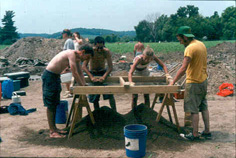 |
Archeology
in the Field (cont.)
|
Introductory text....blah blah blah
Roasting pits, like this one, can also
tell archeologists a good deal about what people ate, how
many there were, and other details about their lives. The
layers of burned material can also be used to help them
date a site to a particular time period.
|
|
|
A roasting pit in profile. Note the layers
of burned material. |
At right, a student excavates a burned limestone roasting
pit.
<<<How did these pits work? Why limestone?>>>
|
|
|
At left is a plan view of
an excavated house showing the location of posts and interior
pit features. |
Another house with interior
features marked.
<<<Do we have a diagram of how this house (or one like
it would have looked?)>>>
|
|
|
|
This
aerial photo clearly illustrates how large a "typical" archeological
excavation can be. Remember also that, in most cases,
the site itself
(a much larger area) will be left untouched for future--and
potentially better--research methods and techniques.
|
Back to the Online Essay: Archeology
Today
Back to the Previous Page |

